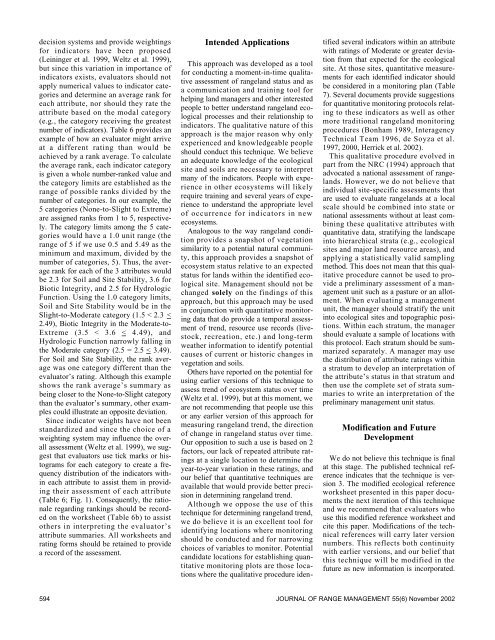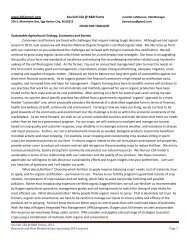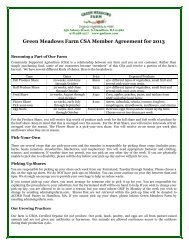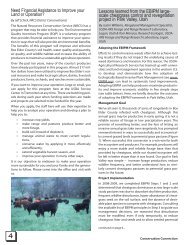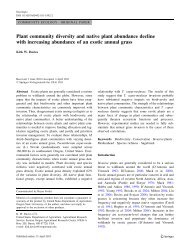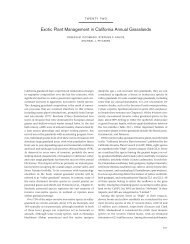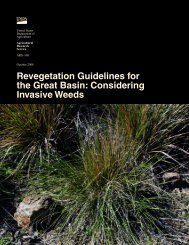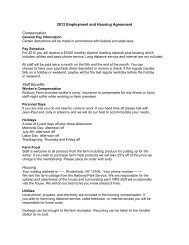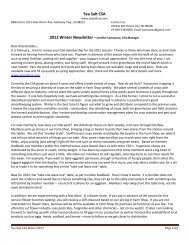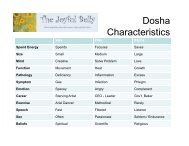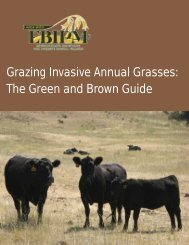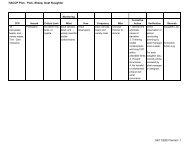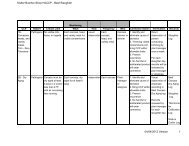Rangeland health attributes and indicators for qualitative assessment
Rangeland health attributes and indicators for qualitative assessment
Rangeland health attributes and indicators for qualitative assessment
Create successful ePaper yourself
Turn your PDF publications into a flip-book with our unique Google optimized e-Paper software.
decision systems <strong>and</strong> provide weightings<br />
<strong>for</strong> <strong>indicators</strong> have been proposed<br />
(Leininger et al. 1999, Weltz et al. 1999),<br />
but since this variation in importance of<br />
<strong>indicators</strong> exists, evaluators should not<br />
apply numerical values to indicator categories<br />
<strong>and</strong> determine an average rank <strong>for</strong><br />
each attribute, nor should they rate the<br />
attribute based on the modal category<br />
(e.g., the category receiving the greatest<br />
number of <strong>indicators</strong>). Table 6 provides an<br />
example of how an evaluator might arrive<br />
at a different rating than would be<br />
achieved by a rank average. To calculate<br />
the average rank, each indicator category<br />
is given a whole number-ranked value <strong>and</strong><br />
the category limits are established as the<br />
range of possible ranks divided by the<br />
number of categories. In our example, the<br />
5 categories (None-to-Slight to Extreme)<br />
are assigned ranks from 1 to 5, respectively.<br />
The category limits among the 5 categories<br />
would have a 1.0 unit range (the<br />
range of 5 if we use 0.5 <strong>and</strong> 5.49 as the<br />
minimum <strong>and</strong> maximum, divided by the<br />
number of categories, 5). Thus, the average<br />
rank <strong>for</strong> each of the 3 <strong>attributes</strong> would<br />
be 2.3 <strong>for</strong> Soil <strong>and</strong> Site Stability, 3.6 <strong>for</strong><br />
Biotic Integrity, <strong>and</strong> 2.5 <strong>for</strong> Hydrologic<br />
Function. Using the 1.0 category limits,<br />
Soil <strong>and</strong> Site Stability would be in the<br />
Slight-to-Moderate category (1.5 < 2.3 <<br />
2.49), Biotic Integrity in the Moderate-to-<br />
Extreme (3.5 < 3.6 < 4.49), <strong>and</strong><br />
Hydrologic Function narrowly falling in<br />
the Moderate category (2.5 = 2.5 < 3.49).<br />
For Soil <strong>and</strong> Site Stability, the rank average<br />
was one category different than the<br />
evaluator’s rating. Although this example<br />
shows the rank average’s summary as<br />
being closer to the None-to-Slight category<br />
than the evaluator’s summary, other examples<br />
could illustrate an opposite deviation.<br />
Since indicator weights have not been<br />
st<strong>and</strong>ardized <strong>and</strong> since the choice of a<br />
weighting system may influence the overall<br />
<strong>assessment</strong> (Weltz et al. 1999), we suggest<br />
that evaluators use tick marks or histograms<br />
<strong>for</strong> each category to create a frequency<br />
distribution of the <strong>indicators</strong> within<br />
each attribute to assist them in providing<br />
their <strong>assessment</strong> of each attribute<br />
(Table 6; Fig. 1). Consequently, the rationale<br />
regarding rankings should be recorded<br />
on the worksheet (Table 6b) to assist<br />
others in interpreting the evaluator’s<br />
attribute summaries. All worksheets <strong>and</strong><br />
rating <strong>for</strong>ms should be retained to provide<br />
a record of the <strong>assessment</strong>.<br />
Intended Applications<br />
This approach was developed as a tool<br />
<strong>for</strong> conducting a moment-in-time <strong>qualitative</strong><br />
<strong>assessment</strong> of rangel<strong>and</strong> status <strong>and</strong> as<br />
a communication <strong>and</strong> training tool <strong>for</strong><br />
helping l<strong>and</strong> managers <strong>and</strong> other interested<br />
people to better underst<strong>and</strong> rangel<strong>and</strong> ecological<br />
processes <strong>and</strong> their relationship to<br />
<strong>indicators</strong>. The <strong>qualitative</strong> nature of this<br />
approach is the major reason why only<br />
experienced <strong>and</strong> knowledgeable people<br />
should conduct this technique. We believe<br />
an adequate knowledge of the ecological<br />
site <strong>and</strong> soils are necessary to interpret<br />
many of the <strong>indicators</strong>. People with experience<br />
in other ecosystems will likely<br />
require training <strong>and</strong> several years of experience<br />
to underst<strong>and</strong> the appropriate level<br />
of occurrence <strong>for</strong> <strong>indicators</strong> in new<br />
ecosystems.<br />
Analogous to the way rangel<strong>and</strong> condition<br />
provides a snapshot of vegetation<br />
similarity to a potential natural community,<br />
this approach provides a snapshot of<br />
ecosystem status relative to an expected<br />
status <strong>for</strong> l<strong>and</strong>s within the identified ecological<br />
site. Management should not be<br />
changed s o l e l y on the findings of this<br />
approach, but this approach may be used<br />
in conjunction with quantitative monitoring<br />
data that do provide a temporal <strong>assessment</strong><br />
of trend, resource use records (livestock,<br />
recreation, etc.) <strong>and</strong> long-term<br />
weather in<strong>for</strong>mation to identify potential<br />
causes of current or historic changes in<br />
vegetation <strong>and</strong> soils.<br />
Others have reported on the potential <strong>for</strong><br />
using earlier versions of this technique to<br />
assess trend of ecosystem status over time<br />
(Weltz et al. 1999), but at this moment, we<br />
are not recommending that people use this<br />
or any earlier version of this approach <strong>for</strong><br />
measuring rangel<strong>and</strong> trend, the direction<br />
of change in rangel<strong>and</strong> status over time.<br />
Our opposition to such a use is based on 2<br />
factors, our lack of repeated attribute ratings<br />
at a single location to determine the<br />
year-to-year variation in these ratings, <strong>and</strong><br />
our belief that quantitative techniques are<br />
available that would provide better precision<br />
in determining rangel<strong>and</strong> trend.<br />
Although we oppose the use of this<br />
technique <strong>for</strong> determining rangel<strong>and</strong> trend,<br />
we do believe it is an excellent tool <strong>for</strong><br />
identifying locations where monitoring<br />
should be conducted <strong>and</strong> <strong>for</strong> narrowing<br />
choices of variables to monitor. Potential<br />
c<strong>and</strong>idate locations <strong>for</strong> establishing quantitative<br />
monitoring plots are those locations<br />
where the <strong>qualitative</strong> procedure identified<br />
several <strong>indicators</strong> within an attribute<br />
with ratings of Moderate or greater deviation<br />
from that expected <strong>for</strong> the ecological<br />
site. At those sites, quantitative measurements<br />
<strong>for</strong> each identified indicator should<br />
be considered in a monitoring plan (Table<br />
7). Several documents provide suggestions<br />
<strong>for</strong> quantitative monitoring protocols relating<br />
to these <strong>indicators</strong> as well as other<br />
more traditional rangel<strong>and</strong> monitoring<br />
procedures (Bonham 1989, Interagency<br />
Technical Team 1996, de Soyza et al.<br />
1997, 2000, Herrick et al. 2002).<br />
This <strong>qualitative</strong> procedure evolved in<br />
part from the NRC (1994) approach that<br />
advocated a national <strong>assessment</strong> of rangel<strong>and</strong>s.<br />
However, we do not believe that<br />
individual site-specific <strong>assessment</strong>s that<br />
are used to evaluate rangel<strong>and</strong>s at a local<br />
scale should be combined into state or<br />
national <strong>assessment</strong>s without at least combining<br />
these <strong>qualitative</strong> <strong>attributes</strong> with<br />
quantitative data, stratifying the l<strong>and</strong>scape<br />
into hierarchical strata (e.g., ecological<br />
sites <strong>and</strong> major l<strong>and</strong> resource areas), <strong>and</strong><br />
applying a statistically valid sampling<br />
method. This does not mean that this <strong>qualitative</strong><br />
procedure cannot be used to provide<br />
a preliminary <strong>assessment</strong> of a management<br />
unit such as a pasture or an allotment.<br />
When evaluating a management<br />
unit, the manager should stratify the unit<br />
into ecological sites <strong>and</strong> topographic positions.<br />
Within each stratum, the manager<br />
should evaluate a sample of locations with<br />
this protocol. Each stratum should be summarized<br />
separately. A manager may use<br />
the distribution of attribute ratings within<br />
a stratum to develop an interpretation of<br />
the attribute’s status in that stratum <strong>and</strong><br />
then use the complete set of strata summaries<br />
to write an interpretation of the<br />
preliminary management unit status.<br />
Modification <strong>and</strong> Future<br />
Development<br />
We do not believe this technique is final<br />
at this stage. The published technical reference<br />
indicates that the technique is version<br />
3. The modified ecological reference<br />
worksheet presented in this paper documents<br />
the next iteration of this technique<br />
<strong>and</strong> we recommend that evaluators who<br />
use this modified reference worksheet <strong>and</strong><br />
cite this paper. Modifications of the technical<br />
references will carry later version<br />
numbers. This reflects both continuity<br />
with earlier versions, <strong>and</strong> our belief that<br />
this technique will be modified in the<br />
future as new in<strong>for</strong>mation is incorporated.<br />
594 JOURNAL OF RANGE MANAGEMENT 55(6) November 2002


